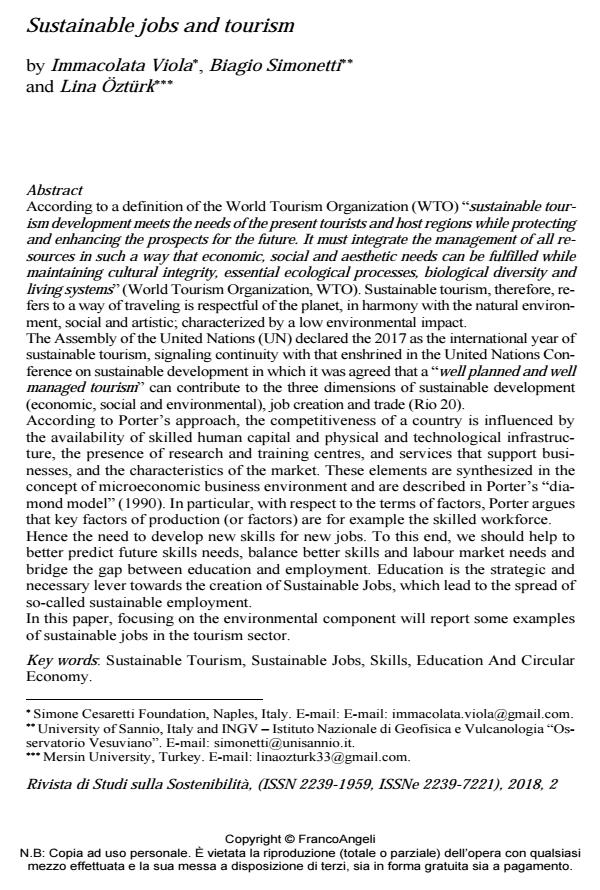Sustainable jobs and tourism
Journal title RIVISTA DI STUDI SULLA SOSTENIBILITA'
Author/s Immacolata Viola, Biagio Simonetti, Lina Öztürk
Publishing Year 2019 Issue 2018/2
Language English Pages 12 P. 45-56 File size 199 KB
DOI 10.3280/RISS2018-002004
DOI is like a bar code for intellectual property: to have more infomation
click here
Below, you can see the article first page
If you want to buy this article in PDF format, you can do it, following the instructions to buy download credits

FrancoAngeli is member of Publishers International Linking Association, Inc (PILA), a not-for-profit association which run the CrossRef service enabling links to and from online scholarly content.
According to a definition of the World Tourism Organization (WTO) "sustainable tourism development meets the needs of the present tourists and host regions while protecting and enhancing the prospects for the future. It must integrate the management of all resources in such a way that economic, social and aesthetic needs can be fulfilled while maintaining cultural integrity, essential ecological processes, biological diversity and living systems" (World Tourism Organization, WTO). Sustainable tourism, therefore, refers to a way of traveling is respectful of the planet, in harmony with the natural environment, social and artistic; characterized by a low environmental impact. The Assembly of the United Nations (UN) declared the 2017 as the international year of sustainable tourism, signaling continuity with that enshrined in the United Nations Conference on sustainable development in which it was agreed that a "well planned and well managed tourism" can contribute to the three dimensions of sustainable development (economic, social and environmental), job creation and trade (Rio 20). According to Porter’s approach, the competitiveness of a country is influenced by the availability of skilled human capital and physical and technological infrastruc-ture, the presence of research and training centres, and services that support busi-nesses, and the characteristics of the market. These elements are synthesized in the concept of microeconomic business environment and are described in Porter’s "di-amond model" (1990). In particular, with respect to the terms of factors, Porter argues that key factors of production (or factors) are for example the skilled work-force. Hence the need to develop new skills for new jobs. To this end, we should help to better predict future skills needs, balance better skills and labour market needs and bridge the gap between education and employment. Education is the strategic and necessary lever towards the creation of Sustainable Jobs, which lead to the spread of so-called sustainable employment. In this paper, focusing on the environmental component will report some examples of sustainable jobs in the tourism sector.
Keywords: Sustainable Tourism, Sustainable Jobs, Skills, Education And Circular Economy.
- Borrelli I.P., Andreopoulou Z.S. (2015). Knowledge, Food Systems and Well-being Sustainability. Review of Studies on Sustainability.
- Cesaretti G.P., Misso R., Viola I., Borrelli I.P. (2013). Enviromental issue and employment: competitiveness or convergence? Economia e Diritto Agroalimentare, 18(1): 55-68.
- Cesaretti G.P., Viola I., Misso R., Borrelli I.P. (2013). Green society – a conceptual framework of sustainability from a territorial perspective. Quality – Access to Success, 14: 50-67.
- Cici C., Schmidt di Friedberg P., in Bianchi Michela (1998), L’arte del viaggio – ragioni e poesia di un turismo sostenibile. Milano: MC Editrice.
- Commissione Europea (2003). Conferenza Europea sullo Sviluppo Rurale “L’Europa Rurale – Prospettive per il Futuro”, Cork, Irlanda.
- De Angelis M.C. (2016). Poverty balanced well-Being and Knowledge: challenges to Sustainability. Review of Studies on Sustainability, 2.
- Developpement touristique durable, n. 84, 1997, Consiglio d’Europa.
- Kathleen K., D’arcy D., An Overview: Tourism Non-governmental Organizations and Poverty Reduction in Developing Countries. Asia Pacific Journal of Tourism Research, 14(2), Tourism for Development: Perspectives and Challenges.
- Martini U. (2005). Management dei sistemi territoriali. Gestione e marketing delle destinazioni turistiche. Torino: Giappichelli.
- Porter M.E. (1998). The Competitive Advantage of Nations. New York: Free Press, MacMillan.
- Ritchie J.R.B., Crouch G.I. (2000). The competitive destination: a sustain-ability perspective. Tourism Management, XXI: 1-7.
- Ruhanen L. (2007). Destination competitiveness: meeting sustainability ob jectives through strategic planning and visioning. In Matias A., Nijkmp P., Neto P. (eds.). Advances in modern tourism research. New York: Physica-Verlag, pp. 133-151.
- Viola I., Pontradolfi A., Manelli A. (2015). The employment crisis and green orientation in agriculture: New educational models. Agriculture and Agricultural Science Procedia, 8, 2016: 560-565.
Immacolata Viola, Biagio Simonetti, Lina Öztürk, Sustainable jobs and tourism in "RIVISTA DI STUDI SULLA SOSTENIBILITA'" 2/2018, pp 45-56, DOI: 10.3280/RISS2018-002004